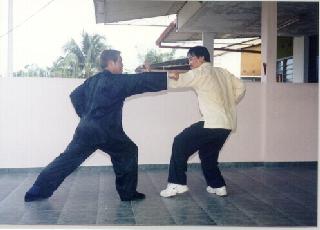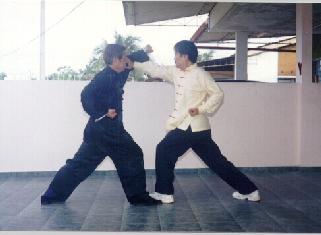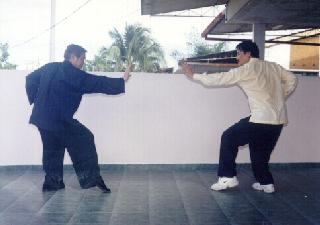QUIZ ON COMBAT -- SERIES 5

|

|

|

|

|

|

|

|

|

|
Here is a series of quizzes to test and help you to revise your understanding of combat principles. Series 1 refers to the review webpage on Combat Sequence 1, Series 2 refers to the review webpage on Combat Sequence 2, and so on. Consult the respective webpages if needed.
Those attending the Special Shaolin Kungfu Course (by invitation only) should complete the quizzes successfully as part of their preparation.
Go to the answers (assessable from a link found at the bottom of the page) only when you are quite sure the ones given by you are correct. In other words, check the answers not for curiosity but for confirmation.
Combat Quiz Series 5
-
The main objective of combat sequence training, contrary to what many students believe, is not learning combative techniques but developing combative skills. In Combat Sequences 1 to 4, the following ten basic skills are developed: right timing, right spacing, flowing movement and force, right judgment, fast decision, instantaneous change, footwork adjustment, safe coverage, flowing attack, and pressing attack Of these ten basic skills, which two are the most important?
-
To help you progress gradually and surely, combat sequences are practiced in progressive stages, as follows: pre-choice, self-choice, end-point continuation, mid-point continuation, and end-point addition. After these, there are five more stages before free sparring, namely surprised counter, external change, internal change, mid-point addition and initial addition.
Suppose you start an encounter with Combat Sequence 4, but just before you could continue with “Golden Star”, your sparring partner executes a “Black Tiger” after sweeping at your low punch. Following this change, you continue with Combat Sequence 5 without disengaging from the encounter.
This encounter therefore consists of two sequences linked smoothly together, and two of the ten stages mentioned above are involved. What are these two stages? -
You start the next encounter with Combat Sequence 5, After striking you with “Green Dragon” to which you respond with “Single Tiger” at the end of the sequence and before you disengage from the encounter, your sparring partner moves in with “Golden Leopard” to your head. You correctly respond with “Golden Dragon”, then both of you disengage.
He could use any other attack pattern instead of “Golden Leopard”. He could use, for example, “Black Tiger” to strike your middle level, or a phoenix-eye fist for a low attack, and you could respond accordingly. This extended encounter involves one of the ten progressive stage. What is it? -
If you and your sparring partners have trained the previous four combat sequences well, you will find that neither one of you can beat the other because both of you have the same level of skills and techniques. Hence, in order to beat your opponent, you have to accomplish one or both things. What are they?
-
All the attacking techniques in Combat Sequence 5 are also found in the previous four sequences — middle punch, low punch and horn punch. Yet, they are different. What makes the difference?
Kungfu Terms in Chinese)
(Henceforth, only the Cantonese pronunciation is given)
Right timing = fai man.
Right spacing = khoi lei.
Flowing movement and force = shun low.
Right judgment = phoon thun.
Fast decision = khuit thun.
Instantaneous change = khap pin.
Footwork adjustment = woon pou.
Safe coverage = wu wai
Flowing attack = lau sau.
Pressing attack = phik ta.
Pre-choice = sheen shwun.
Self-choice = chi shwun.
End-point continuation = mei chip.
Mid-point continuation = choong chip.
End end-point addition = mei yiap.
Surprised counter = khai khaik.
External change = ngoi phin.
Internal change = noi phin.
Mid-point addition = choong yiap.
Initial addition = tao yiap.
